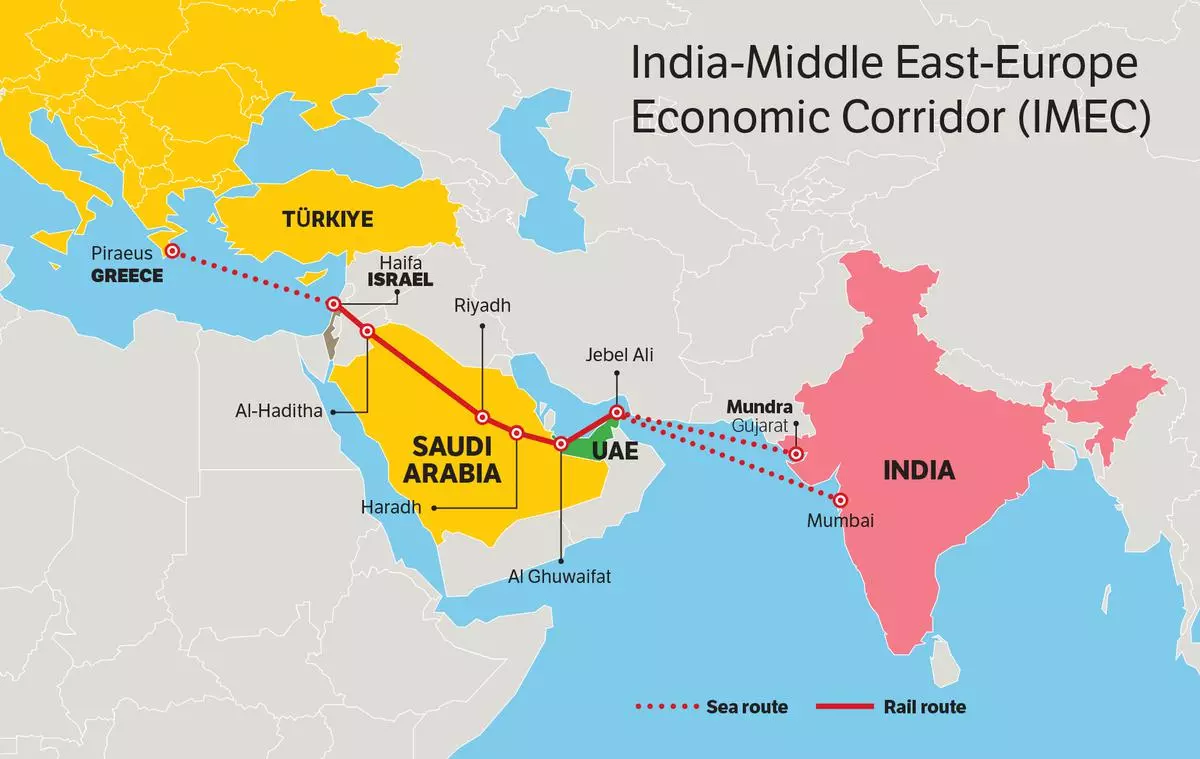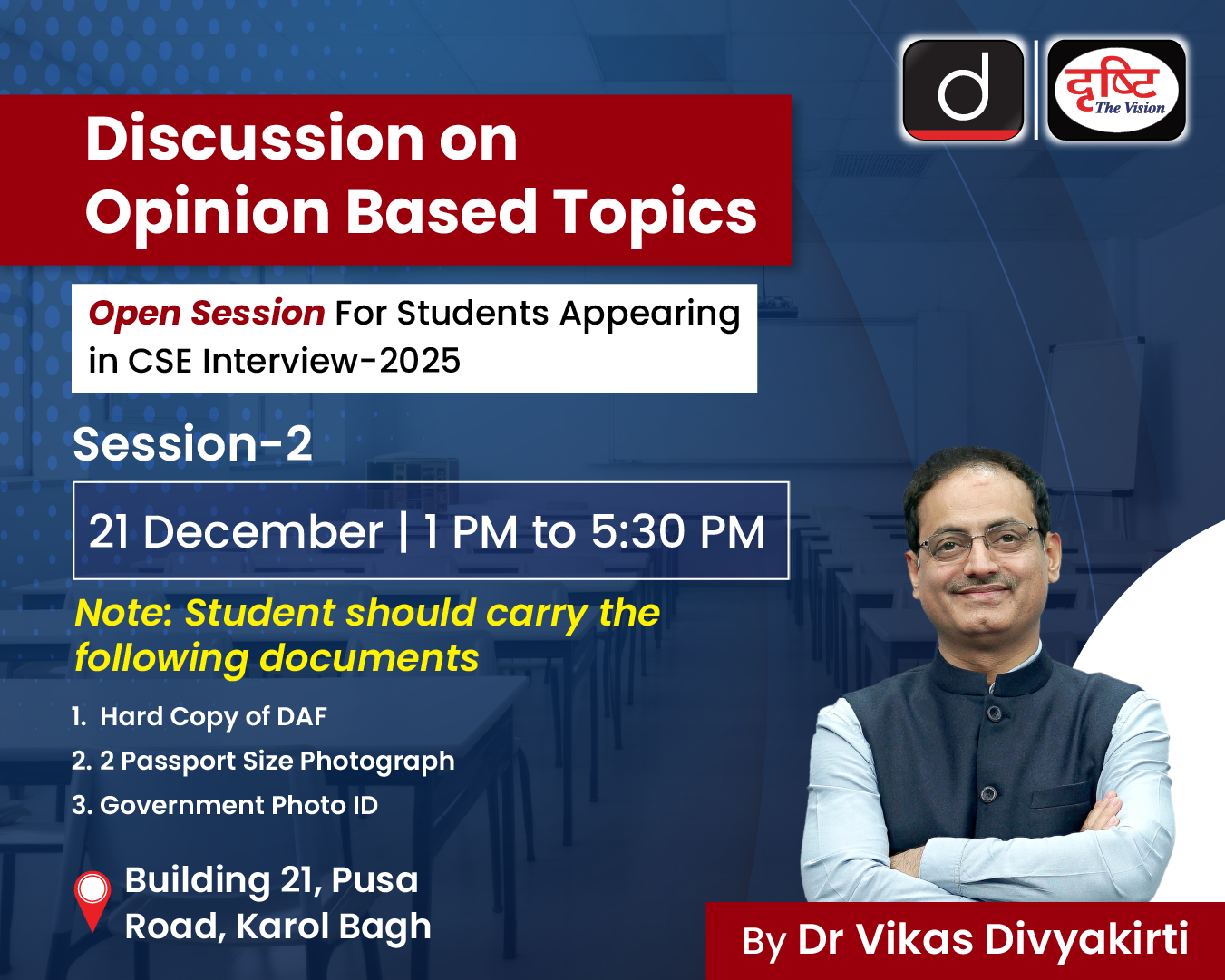Facts for UPSC Mains
India-Middle East–Europe Economic Corridor
- 18 Oct 2025
- 10 min read
Why in News?
The India–Middle East–Europe Economic Corridor (IMEC), unveiled at the 2023 G20 Summit, aims to link India with Europe through the Middle East.
- However, ongoing conflicts in West Asia and emerging Arctic routes pose serious challenges to its implementation and strategic viability.
What is India-Middle East–Europe Economic Corridor?
- About: IMEC is a strategic multi-modal connectivity initiative launched through a MoU at the G20 Summit 2023, New Delhi. It has two corridor segments Eastern Corridor (connects India to the Gulf region) and Northern Corridor (connects the Gulf region to Europe).
- IMEC signatories include India, US, Saudi Arabia, UAE, France, Germany, Italy, and the EU. It is part of the G7’s Partnership for Global Infrastructure and Investment (PGII, 2021).
- The IMEC emerged in 2023 amid favourable geopolitics, supported by the Abraham Accords and improving India-UAE, Saudi Arabia, and US ties. It aims to link Israel’s Haifa port with Jordanian railways and Gulf ports.
- Purpose: IMEC aims to develop an integrated network of ports, railways, roads, sea lines, energy pipelines, and digital infrastructure (undersea digital cables) to enhance trade and economic cooperation between India, the Middle East, and Europe.
- IMEC is designed as a transparent, sustainable, and debt-free alternative to China’s Belt and Road Initiative (BRI), ensuring infrastructure development without compromising national sovereignty.
- Economic & Strategic Benefits for India: IMEC reduces logistics costs by ~30% and transport time by ~40% versus the Suez Canal route, boosting export competitiveness.
- For India, IMEC is a strategic opportunity to diversify trade routes, reducing reliance on chokepoints like the Suez Canal. The corridor enhances access to European markets via the Mediterranean, providing an alternative to China’s BRI.
- With the EU as one of India's largest trading partners (USD 136 billion in 2024-25), stronger connectivity could boost export competitiveness.
- IMEC also aligns with India’s Act West policy, deepening engagement with the Middle East for energy security, remittances, and diaspora links, while countering Pakistan’s regional strategic influence.
- It aligns with India’s One Sun One World One Grid (OSOWOG) initiative to harness solar and green hydrogen energy from the Middle East and supports India’s transition to a low-carbon economy.
- For India, IMEC is a strategic opportunity to diversify trade routes, reducing reliance on chokepoints like the Suez Canal. The corridor enhances access to European markets via the Mediterranean, providing an alternative to China’s BRI.
What are the Key Challenges to the India–Middle East–Europe Economic Corridor (IMEC)?
- Geopolitical Instability in West Asia: The Hamas attack in October 2025 and subsequent Israeli military actions have worsened regional security, especially between Israel and Arab states, threatening the core IMEC route.
- Deterioration in Israel’s ties with countries like Saudi Arabia and Jordan could stall railway and energy infrastructure projects planned through their territories.
- West Asia’s volatile political climate makes long-term infrastructure investments risky and uncertain.
- Shifting Trade Dynamics Due to Climate Change: Arctic sea routes, now more accessible due to climate change, offer shorter, cost-effective shipping routes between Asia and Europe, reducing IMEC’s competitive edge.
- Countries like the US, Russia, China, and northern Europe stand to benefit more from Arctic connectivity than IMEC signatories.
- Mediterranean countries like Italy and France view IMEC as a counterweight to potential economic marginalization due to Arctic routes.
- Red Sea Disruptions and Maritime Insecurity: Frequent attacks by Houthi rebels in the Red Sea have disrupted shipping, leading to detours via the Cape of Good Hope, increasing transport time and cost.
- IMEC, depending on maritime segments near conflict zones, faces exposure to similar disruptions.
- Exclusion of Regional Actors and Strategic Competition: Countries like Turkey, Egypt, or Iran are not part of IMEC, despite their strategic geography, potentially creating rival or parallel corridors.
- Pakistan’s growing ties with Arab states, especially Saudi Arabia, could be leveraged to counter IMEC and undermine India’s influence in the region.
- Implementation and Investment Challenges: Building high-speed rail, energy pipelines, and digital infrastructure across multiple sovereign territories requires enormous financial and technical resources.
- IMEC aims to mobilize USD 600 billion by 2027, but lacks a definitive funding roadmap and cost-sharing plan among stakeholders.
- Large-scale infrastructure requires long-term investments (USD 3–8 billion per project), which remains uncertain amid global economic slowdown.
- Uncertain Peace Prospects in the Gaza Conflict: Even as peace initiatives are proposed, there is no guarantee of long-term stability in Gaza or the broader Israel-Palestine region.
- Any future flare-ups could derail ongoing or planned segments of the corridor, especially in Israel and Jordan.
What Strategies can India Adopt to Ensure Successful Implementation of the IMEC?
- Foster Multilateral Cooperation and Governance: India should take the lead to establish an IMEC Secretariat for coordination, dispute resolution, and monitoring, while promoting policy harmonization and regulatory alignment among member countries.
- Strengthen Geopolitical Engagement: India should maintain active diplomatic outreach with all member countries and regional players.
- Facilitate conflict resolution to address West Asian instability (e.g., Gaza conflict, Saudi-Iran rivalry).
- Promote inclusion of Turkey, Iran, Qatar, and Egypt, and engage additional Saudi and Egyptian ports to expand IMEC’s reach, strengthen India-Arab economic ties, and counter Pakistan’s regional influence.
- Secure Investment Commitments: Develop a clear financial roadmap and cost-sharing mechanisms among member nations.
- Leverage Public-Private Partnerships (PPPs), green bonds, and sustainable finance to ease budget pressure.
- Mitigate Trade and Security Risks: Diversify routes and build contingency plans against maritime disruptions.
- Strengthen regional security cooperation via Indian Ocean Rim Association (IORA) and Gulf Cooperation Council (GCC) to counter piracy, terrorism, and cyber threats.
- Promote Technological Integration: India can lead digital connectivity initiatives like Unified Payments Interface (UPI)-based payments, undersea data cables, and 5G infrastructure. And Support e-commerce, fintech, and smart city projects while reducing the digital divide along IMEC nodes.
Conclusion
IMEC offers India a strategic pathway to diversify trade, strengthen connectivity with Europe and the Middle East, and enhance export competitiveness. While challenges persist, coordinated engagement, robust infrastructure, and technological integration can unlock significant economic opportunities, positioning India as a key driver of prosperity across the corridor.
|
Drishti Mains Question: Critically examine the strategic and economic significance of the India–Middle East–Europe Economic Corridor (IMEC) for India. |
Frequently Asked Questions (FAQs)
1. What is the India–Middle East–Europe Economic Corridor (IMEC)?
IMEC is a multi-modal connectivity initiative launched at the G20 Summit 2023 to link India, the Middle East, and Europe via ports, railways, energy pipelines, and digital infrastructure.
2. Which countries are signatories of IMEC?
India, US, Saudi Arabia, UAE, France, Germany, Italy, and the European Union are the current IMEC signatories.
3. What are the strategic benefits of IMEC for India?
IMEC reduces logistics costs (~30%) and transport time (~40%) versus the Suez Canal, enhances export competitiveness, supports India’s OSOWOG energy goals, and strengthens engagement under the Act West policy.
UPSC Civil Services Examination, Previous Year Questions (PYQs)
Prelims:
Q. ‘Belt and Road Initiative’ is sometimes mentioned in the news in the context of the affairs of (2016)
(a) African Union
(b) Brazil
(c) European Union
(d) China
Ans: (d)








